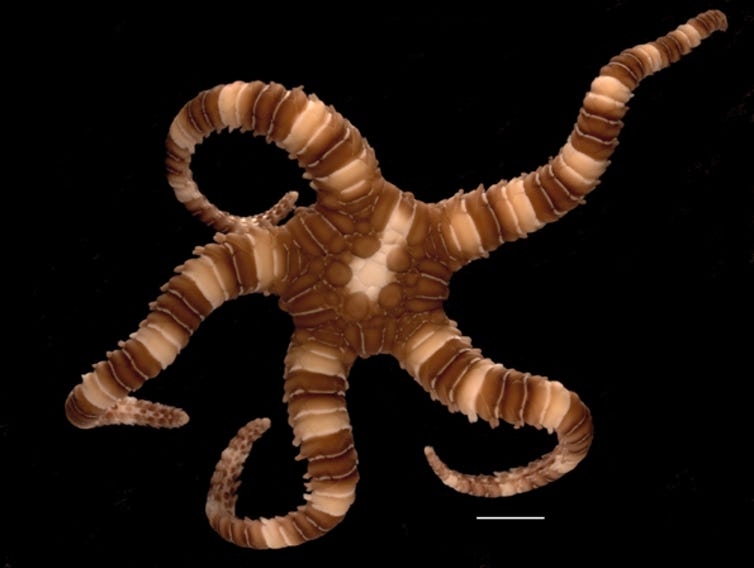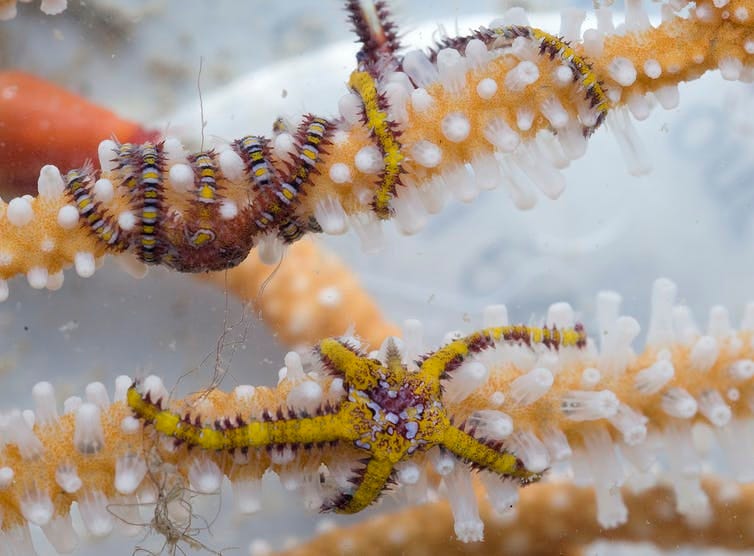From Brittle Stars Grows a 'Tree of Life': How Genes Trace Life on Earth
By Tim O'Hara, Museums Victoria
A complete tree of life – showing how and when organisms are related to each other – has long been desired by biologists, but obscured by the vagaries of the fossil record.
Now, next-generation gene sequencing, capable of sequencing hundreds of millions of pieces of DNA, is not only revolutionising human medicine and agriculture, but also transforming our understanding about the origins and distribution of life on Earth.
Colleagues and I used these techniques to peer back to the Cambrian period (542-488 million years ago) to uncover the relationships between the major classes of echinoderms – a group of marine animals that include the sea stars, sea urchins, brittle stars, sea cucumbers and feather stars – which we [published](http://www.cell.com/current-biology/abstract/S0960-9822(14%2900776-3) last month in the journal Current Biology.
With a bit of care, researchers can produce quality genetic datasets, use these to build an unambiguous tree of relationships and see how life has responded in the past to changing climates. We can also better map biodiversity, identifying areas or species that contain an interesting or unique genetic heritage.
For the love of brittle stars
Our focus was on the brittle stars. Although many people may not be familiar with brittle stars (more technically known as ophiuroids) they are abundant on the seafloor, from coastal reefs and mudflats to the deepest trenches. They are found from the equator to polar regions, and feed on plankton or the occasional small critter unfortunate enough to brush against their extended arms. https://www.youtube.com/embed/Myhp8ifW6ig?wmode=transparent&start=0
But to us, their best attribute is their abundant presence in the collections of the world’s museums. They have been frequently sampled by scientific surveys, identified to species and preserved in a museum. This has two benefits:
it compiles a large database of when, where and how deep these animals have been found
there is a large depository of animal tissue from which we can extract DNA.
Clean datasets of species, with nicely aligned DNA sequences, are hard to produce. There are contaminants, gene duplications, exotic bits of viral DNA called retrotransposons and lots of other complicating problems. But the hard work to tidy up our data was worth the result: a rock-solid tree-of-life that illustrated the origin and diversity of modern brittle stars.
So far, we have found that modern brittle stars date back to just before the great Permian-Triassic extinction event (252 million years ago) which obliterated 95% of all marine life. Most of the ancient Palaeozoic brittle stars disappeared and only a few lineages survived. This is no huge surprise, as this scenario is common across many groups of organisms.
But the subsequent evolution of brittle stars was completely unpredicted. It turns out that many of those convenient external characters that we used to classify brittle stars have evolved independently a number of times and were a pretty poor guide to overall relationships. This means we need to tear up much of our existing classification and begin again.
This is going to make life difficult for the next generation of budding taxonomists trying to get a handle on how to identify brittle stars. But there is a silver lining in the tale. We did find that the differing forms of some minute skeletal characters were consistent with our tree. These minute characters are well preserved in fossil brittle stars.
Brittle stars are rarely preserved intact, but fragments are very common in fossil sediments. Until recently they have been largely put aside because no one knew what to do with them.
Fossil collections of museums can have many jars of little brittle star bones. As now many of these microfossils can be interpreted with some precision, a whole new dataset exists with which to investigate the ecology and evolution of fossil marine assemblages.
What does this mean for species mapping?
Our ultimate goal is to both map the distribution of brittle stars across the globe and produce a detailed tree of life (or phylogeny) that can investigate many of the great questions of marine evolution and biogeography:
when and how often did a deep-sea or a polar fauna arise?
how are the species in different oceans or environments related to each other?
has the number of species being formed changed over time?
what effect did the great extinction events in Earth’s history have on this group of animals?
But there is a practical element to this phylogenetic research as well. If one of the goals of conservation is to preserve genetic heritage of life on the planet, then it may be a good idea to prioritise the protection of the most divergent lineages, species or groups of species that are distantly related from other species and have unusual gene variants.
We can map evolutionary distinctness across a landscape, looking for hotspots of genetic diversity, the marine equivalent of tropical rainforests.
Measuring evolutionary distinctness through DNA profiling may be a rapid way of assessing the conservation values of biological community. There is currently a great interest in mining rare minerals from deep-sea habitats; the first mine is being developed and massive areas of seafloor leased to mining corporations.
At present it is often a difficult and subjective task to compare the fauna of one area to another, particularly for the deep sea, where we know so little about the biology of many species.
A slight difference in the external appearance of a deep-sea animal could indicate a new species or just be a growth response to differing environmental conditions. Quantifying the evolutionary distinctness of a community from species DNA offers a more precise approach.
Perhaps in the future we will not even have to sample the animals directly. All organisms leave traces of their DNA in the environment through shedding tissues, in the faeces of their predators and ultimately, when they die. The emerging field of metagenomics is exploring the potential for detecting organisms through this “environmental DNA”.
All in all, it is an exciting time for marine evolutionary biology. New technologies are rapidly providing the data to answer questions about the evolution of life that have been challenging humanity for hundreds of years.
Tim O'Hara, Senior Curator of Marine Invertebrates, Museums Victoria
This article is republished from The Conversation under a Creative Commons license. Read the original article.





